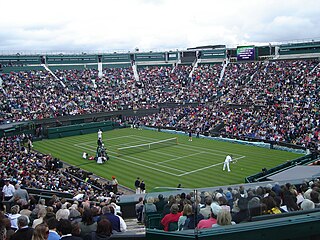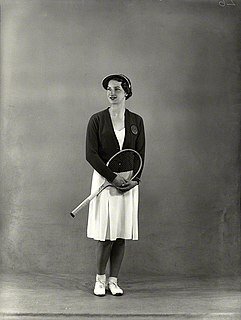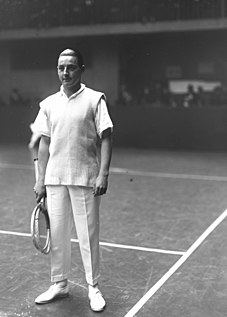Past finals
Singles
| Year | Champion | Runner-up | Score |
|---|---|---|---|
| 1927 | | | 6–3, 6–3, 6–4 |
| 1928 | | | 6–1, 6–3, 5–7, 6–4 |
| Queen's Club Pro | |
|---|---|
| Defunct tennis tournament | |
| Founded | 1927 |
| Abolished | 1928 |
| Editions | 2 |
| Location | London England |
| Venue | Queen's Club |
| Surface | Clay |
The Queen's Club Pro tennis tournament was held in 1927 and 1928. It went by the name of the Professional Championship of the World in 1928 gaining the tournament great notability. The tournament was held in October on clay courts, at the Queen's Club and was hoped that it would become a permanent structure like the amateur championships (grand slams) and be considered one of the big pro events like the US Pro and the Bristol Cup. [1] It was discontinued and wasn't held in 1929. [2]
| Year | Champion | Runner-up | Score |
|---|---|---|---|
| 1927 | | | 6–3, 6–3, 6–4 |
| 1928 | | | 6–1, 6–3, 5–7, 6–4 |

Henry Ellsworth Vines Jr. was an American tennis champion of the 1930s, the World No. 1 player or the co-No. 1 in 1932, 1934, 1935, 1936 and 1937, able to win Pro Slam titles on three different surfaces. He later became a professional golfer, and won three titles on the PGA Tour.

Henri Jean Cochet was a French tennis player. He was a world No. 1 ranked player, and a member of the famous "Four Musketeers" from France who dominated tennis in the late 1920s and early 1930s.
Before the advent of the Open era of tennis competitions in April 1968, only amateurs were allowed to compete in established tournaments, including the four Majors. There was no prize money and players were compensated for travel expenses only. However many top tennis players turned professional to play legally for prize money in the years before the open era. They played in separate professional events, mostly on tours involving head-to-head competition, but also in professional tournaments as the biggest events on the pro tour. Professional tournaments, in particular the professional Majors, usually only had a men's draw.
Hans "Hanne" Nüsslein was a German tennis player and coach and former World professional number 1 tennis player who won four professional Majors singles titles during his career.

Karel Koželuh was a top Czech tennis, association football, and ice hockey player of the 1920s and 1930s. Koželuh never played in the major tournaments of amateur tennis but was an all-around athlete at the highest level.

Vincent "Vinnie" Richards was an American tennis player. He was active in the early decades of the 20th century, particularly known as being a superlative volleyer. He was ranked World No. 2 as an amateur in 1924 by A. Wallis Myers, and was ranked joint World No. 1 pro by Ray Bowers in 1927 and World No. 1 pro by Bowers in 1930.

Francis "Frank" Townsend Hunter was an American tennis player who won an Olympic gold medal.
Bruce Parkhouse Barnes was a high-ranking professional American tennis player of the 1930s.
The U.S. Pro Tennis Championships was the oldest professional tennis tournament played until its final year of 1999 and is considered as a part of the professional Grand Slam from 1927–1967 until the advent of Open Era. In 1953, 1955, 1956, and 1960, the Cleveland World Pro had a women's draw, with Pauline Betz winning the first three of these, and defeating the reigning U.S. women's champion Doris Hart in the 1956 final. Althea Gibson defeated Pauline Betz in the 1960 women's final.
Since 1983, men's tennis has had a very strong tradition and clear hierarchy of tournaments: (1) Grand Slam tournaments, including Wimbledon, the US Open, the French Open, and the Australian Open; (2) the Tennis Masters Cup; and (3) the Davis Cup. Before 1983, however, and in particular before the start of the open era in 1968, the hierarchy of professional tournaments changed virtually every year. For example, in 1934, the U.S. Pro was a high-class tournament with all the best players, but just two years later, this tournament was ordinary because only professional teachers entered the event.

The racket sport traditionally named lawn tennis, invented in Croydon, now commonly known simply as tennis, is the direct descendant of what is now denoted real tennis or royal tennis, which continues to be played today as a separate sport with more complex rules. Most rules of (lawn) tennis derive from this precursor and it is reasonable to see both sports as variations of the same game. Most historians believe that tennis was originated in the monastic cloisters in northern France in the 12th century, but the ball was then struck with the palm of the hand; hence, the name jeu de paume. It was not until the 16th century that rackets came into use, and the game began to be called "tennis." It was popular in England and France, and Henry VIII of England was a big fan of the game, now referred to as real tennis.
The Wembley Championships was a men's professional tennis tournament held from 1934–1990 with some periods of inactivity in between and is often considered to be one of the three Major professional tennis tournaments before the Open Era from 1927–1967 until the advent of the open era. Ken Rosewall's and Rod Laver's six singles titles are the record for this event. The tournament only had a men's draw.
In 1930 the "Association Française des Professeurs de Tennis (AFPT)" held its first pro tournament, titled "Championnat International de France Professionnel" June 18–22, 1930, and is considered as a part of the professional grand slam from 1927 to 1967 till the advent of Open Era. The tournament only had a men's draw.
Robert Ramillon was a French professional tennis player of the 1930s and was the winner of French Pro in 1932. He also played in the finals in 1931 and 1936. In 1928 he won the title at the Queen's Club Pro tournament. He was also runner-up at the Southport tournament in 1937. At the wartime Tournoi de France, held at Roland Garros, he was runner-up in 1941 to Bernard Destremau.

Margaret “Peggy” Amy Michell was a British female tennis player active in the 1920s. She is also known under her married name, Peggy Saunders-Michell.
The International Pro Championship of Britain was a professional men's tennis tournament held at Victoria Park in Southport, England between 1935 and 1939. It was open to professional players only, amateurs were not allowed to compete. The tournament was held on outdoor En-tout-cas, "all-weather" artificial clay and was played in July, except for the 1939 edition, which was held in August. Hans Nüsslein won four consecutive titles from 1936 through 1939.

Mary Hardwick was an English female tennis player who was active during the 1930s and the 1940s.

Albert Burke (1901–1958) was a French-born professional tennis player of Irish descent who described himself as British but was classed as a representative of Ireland and, on other occasions, of France when playing in international tournaments. In 1924 and 1925 he won the Bristol Cup tournament, which was at that time the principal competition for tennis professionals.

Roman Najuch was a professional tennis player and teacher based in Germany. He was born in a location of today's Poland belonging to the Russian Empire at that time. His family moved to Germany, caused by revolutions and wars, and settled in Berlin. One of his first teachers was Georg Kerr who left Germany in 1910. Later he got German citizenship. He took part in the first German Pro Championships 1911 - still with Russian citizenship -, reached the final, but the winner was Karel Koželuh. He won the German Championships in 1913 and 1914. He was teaching at the LTTC Rot-Weiss Tennis Club in Berlin. In October 1925 he became German Champion for the seventh time. In 1928 and 1929 he won German Pro Championships. He was defeated in 1931 by his student Hans Nüsslein after getting the title for eleven times. With Hans Nüsslein, who was 17 years younger, he played in the doubles event. Najuch was the coach of Poland’s Davis Cup team and became president of the International Pro Tennis Federation. His life career was presented on German TV in the series Wie ich angefangen habe (1957–1958). Marshall Jon Fisher called him "one of the world's best players at the time" around the year 1925.
Until the draw of Open tennis in 1968, the usual format for the handful of playing pros was a tour of one-night stands, across the United States and sometimes other countries as well. The champion of the previous tour went head-to-head against a challenger, most often the leading amateur who had turn pro. Whoever the promoter, he lured the leading amateur with a guarantee against a percentage of gate receipts, making a similar type of deal with the champion and generally paying the others' salaries. There were tournament series with point systems for the complete field of pros in 1946, 1959 and 1960 and there were also World Championship tours in these same three years involving only a few pros. The last World Championship tour was held in 1963 and from 1964 onwards a tournament series with a point system determined the number one pro. Some smaller tours continued to be held from 1964 onwards, as there had been since the 1930's era, but lacking the king-of-the hill aspect.